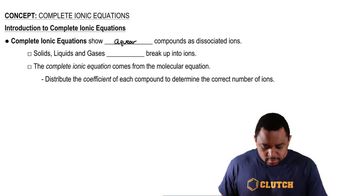Write a molecular equation for the precipitation reaction that occurs (if any) when each pair of aqueous solutions is mixed. If no reaction occurs, write 'NO REACTION.' a. sodium chloride and lead(II) acetate b. potassium sulfate and strontium iodide c. cesium chloride and calcium sulfide d. chromium(III) nitrate and sodium phosphate
Ch.4 - Chemical Quantities & Aqueous Reactions

Chapter 4, Problem 79c,d
Write balanced complete ionic and net ionic equations for each reaction.
c. NaOH(aq) + HC2H3O2(aq) → H2O(l ) + NaC2H3O2(aq)
d. Na3PO4(aq) + NiCl2(aq) → Ni3(PO4)2(s) + NaCl(aq)
 Verified step by step guidance
Verified step by step guidance1
Identify the states of matter for each compound: NaOH(aq), HC_2H_3O_2(aq), H_2O(l), and NaC_2H_3O_2(aq).
Write the balanced molecular equation: NaOH(aq) + HC_2H_3O_2(aq) → H_2O(l) + NaC_2H_3O_2(aq).
Break down the aqueous compounds into their ions to write the complete ionic equation: Na^+(aq) + OH^-(aq) + HC_2H_3O_2(aq) → H_2O(l) + Na^+(aq) + C_2H_3O_2^-(aq).
Identify the spectator ions, which are ions that appear on both sides of the complete ionic equation without undergoing any change. In this case, Na^+(aq) is the spectator ion.
Write the net ionic equation by removing the spectator ions: OH^-(aq) + HC_2H_3O_2(aq) → H_2O(l) + C_2H_3O_2^-(aq).

Verified video answer for a similar problem:
This video solution was recommended by our tutors as helpful for the problem above.
Video duration:
4mWas this helpful?
Key Concepts
Here are the essential concepts you must grasp in order to answer the question correctly.
Complete Ionic Equation
A complete ionic equation represents all the ions present in a solution during a chemical reaction. It shows the reactants and products in their ionic forms, highlighting the dissociation of soluble ionic compounds in aqueous solutions. This equation is essential for understanding how ions interact in solution and sets the stage for identifying the net ionic equation.
Recommended video:
Guided course

Complete Ionic Equations
Net Ionic Equation
The net ionic equation simplifies the complete ionic equation by removing spectator ions—ions that do not participate in the actual chemical reaction. This equation focuses on the species that undergo a change, providing a clearer picture of the chemical process. It is crucial for understanding the essence of the reaction and the formation of products.
Recommended video:
Guided course

Net Ionic Equations
Acid-Base Reaction
An acid-base reaction involves the transfer of protons (H⁺ ions) between reactants, typically resulting in the formation of water and a salt. In the given reaction, sodium hydroxide (a base) reacts with acetic acid (an acid) to produce water and sodium acetate. Understanding this concept is vital for predicting the products and writing the corresponding ionic equations.
Recommended video:
Guided course

Acid-Base Reaction
Related Practice
Textbook Question
1207
views
Textbook Question
Write balanced complete ionic and net ionic equations for each reaction. a. HCl(aq) + LiOH(aq) → H2O(l) + LiCl(aq)
921
views
Textbook Question
Write balanced complete ionic and net ionic equations for each reaction. b. MgS(aq) + CuCl2(aq) → CuS(s) + MgCl2(aq)
676
views
Textbook Question
Write balanced complete ionic and net ionic equations for each reaction.
a. K2SO4(aq) + CaI2(aq) → CaSO4(s) + KI(aq)
b. NH4Cl(aq) + NaOH(aq) → H2O(l) + NH3(g) + NaCl(aq)
c. AgNO3(aq) + NaCl(aq) → AgCl(s) + NaNO3(aq)
860
views
Textbook Question
Write balanced complete ionic and net ionic equations for each reaction. a. K2SO4(aq) + CaI2(aq) → CaSO4(s) + KI(aq)
Textbook Question
Write balanced complete ionic and net ionic equations for each reaction. d. HC2H3O2(aq) + K2CO3(aq) → H2O(l ) + CO2(g) + KC2H3O2(aq)
851
views
